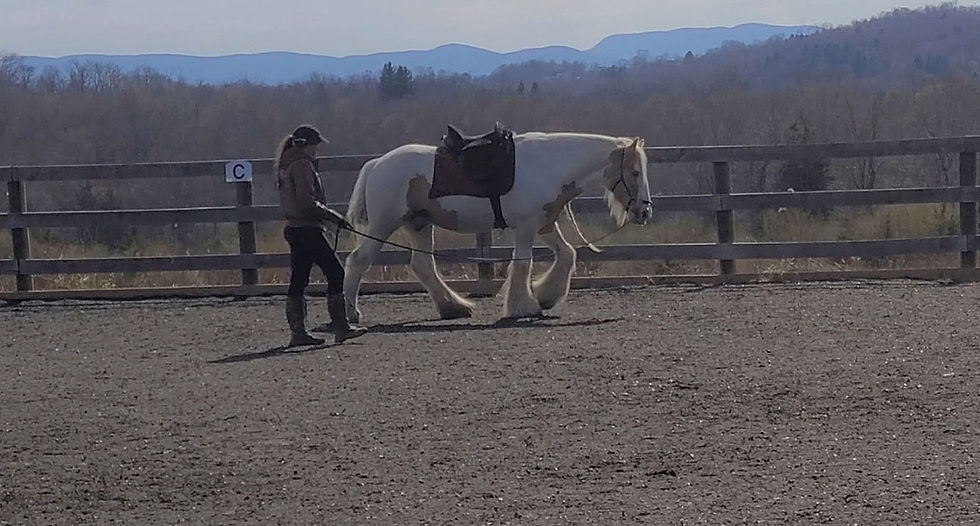Building Language with Horses through Binary Code
- Heather Meyer Horsemanship
- Sep 5, 2021
- 4 min read

All complex systems and languages come into existence from two oppositional concepts ... light verses dark, positive verses negative, something verses nothing, etc. In fact, all modern technology is generated by the two elemental states "on" or "off" represented in computer language by the digits "1" and "0". This is referred to as binary code.
This principle should not be underestimated or undervalued in our horsemanship. To offer our horses the best possible chance of understanding something, it's only logical to think about educating them using binary code. This is the best way to build a cue system. We show them the cue we would like them to learn, and then show them what it means in their natural language. And we do this by applying a binary system of actions: stimulus vs. release of stimulus.
The horse's natural language is energy. They direct varying degrees of energetic pressure towards each other to stimulate responses. They then release that pressure when they get a response from the other horse. In learning theory, this is called negative reinforcement. It is when you apply a stimulus and then release it (negate it) when the desired behavior presents itself.
This is a binary system. Stimulus vs. release of stimulus. Say a horse is quietly munching from a pile of hay in his field. One of his herdmates sees the pile and decides he wants it himself. He walks towards the pile with pinned ears. The eating horse feels pressure (stimulus) from the momentum (intention) of the approaching horse's energy. This disrupts his natural calm state, and he begins seeking release from that energetic pressure. He moves away. The approaching horse releases the pressure (release of stimulus) and begins munching from the pile of hay. The first horse has learned that when this particular horse approaches with pinned ears, he should move out of the way unless his wants his calm state disrupted.
Any stimulus that invokes a response from the horse can be used as one half of the binary code. The release of that stimulus is the other half. So stimulus vs. release of stimulus is the most elemental aspect of educating horses using their natural language.
Good trainers realize the significance of giving clear releases. It's how the horse knows when he finds the correct answer. The release is a pivotal point during the sequence of actions we take to teach a cue. Without it, the horse CANNOT learn something cognitively and it is unfair to expect him to do so. So if I want my horse to learn to step his hind end over when I touch his hip, I need to follow that touch with energetic pressure, hold the pressure until he offers a response, and then release to an energetically neutral state instantly. And I need to remain in that energetically neutral state until the horse to returns to his own energetically neutral state. This pause in between requests gives him time to process the correlation between the cue (touching the hip) and the response (stepping over).
Energetic pressure from humans can be overwhelming for horses at first, especially if they have had scary or confusing experiences with people in the past. Horses need to learn how to handle pressure and we need to be mindful of their thresholds, never going beyond their comfort zone for too long before allowing them to retreat back to a calm, neutral state. Using a very clear binary system like this right from the start, while carefully monitoring and acknowledging the horse's energetic thresholds and tries, can help him understand that HE CAN CONTROL pressure.
It's important that we know what behaviors we are looking for, and release not just when we achieve the desired behavior, but when we achieve any response that may lead to the desired behavior. This is called shaping. Furthermore, we should release to any behavior that we want to reinforce ... even if its not what we are looking for initially. This way the behavior will be more likely to come up again. We should actually be looking for ANY OPPORTUNITY to release, so the horse stays motivated to try and empowered to figure things out. And as long as we offer immediate, frequent releases consistently, and only apply pressure while the horse is in a calm state, we can build his interest in the learning process. This will also build his confidence in our ability to guide him to answers.
A straight forward, binary system of communicating can help us build strong foundational cue systems with our horses. We can then use this basic language to challenge our horses with increasingly more complex tasks as their education progresses. Essentially, we are teaching them words, that can then be used to form sentences and phrases. They get good at learning because we are using a process that develops their attention spans and cognitive abilities. We are also cultivating their curiosity and desire to interact by reinforcing strategically and giving them what they need to be successful. If all other languages originate from binary understanding, then why should we expect the language we build with our horses to be any different? It's simply what works,
and the best chance they have at understanding what we want.































Comments